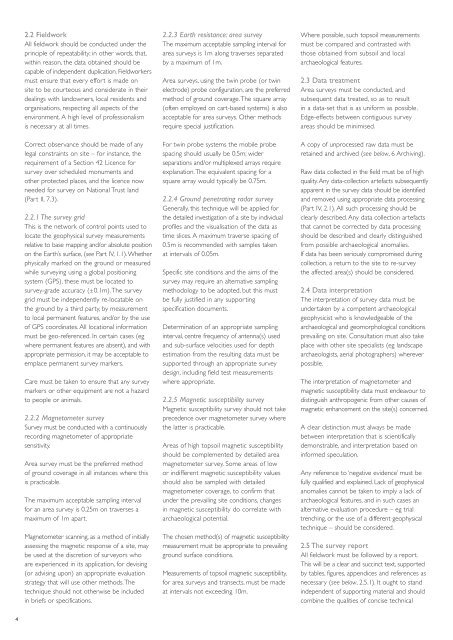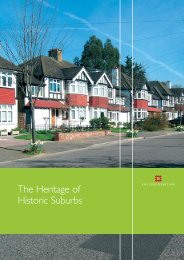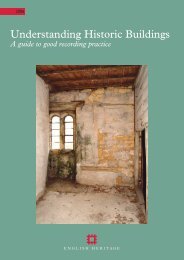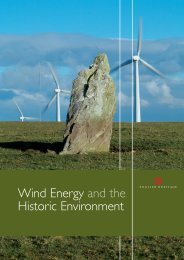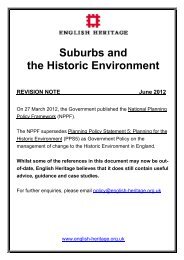Geophysical Survey in Archaeological Field Evaluation - HELM
Geophysical Survey in Archaeological Field Evaluation - HELM
Geophysical Survey in Archaeological Field Evaluation - HELM
You also want an ePaper? Increase the reach of your titles
YUMPU automatically turns print PDFs into web optimized ePapers that Google loves.
4<br />
2.2 <strong>Field</strong>work<br />
All fieldwork should be conducted under the<br />
pr<strong>in</strong>ciple of repeatability; <strong>in</strong> other words, that,<br />
with<strong>in</strong> reason, the data obta<strong>in</strong>ed should be<br />
capable of <strong>in</strong>dependent duplication. <strong>Field</strong>workers<br />
must ensure that every effort is made on<br />
site to be courteous and considerate <strong>in</strong> their<br />
deal<strong>in</strong>gs with landowners, local residents and<br />
organisations, respect<strong>in</strong>g all aspects of the<br />
environment. A high level of professionalism<br />
is necessary at all times.<br />
Correct observance should be made of any<br />
legal constra<strong>in</strong>ts on site – for <strong>in</strong>stance, the<br />
requirement of a Section 42 Licence for<br />
survey over scheduled monuments and<br />
other protected places, and the licence now<br />
needed for survey on National Trust land<br />
(Part II, 7.3).<br />
2.2.1 The survey grid<br />
This is the network of control po<strong>in</strong>ts used to<br />
locate the geophysical survey measurements<br />
relative to base mapp<strong>in</strong>g and/or absolute position<br />
on the Earth’s surface, (see Part IV, 1.1). Whether<br />
physically marked on the ground or measured<br />
while survey<strong>in</strong>g us<strong>in</strong>g a global position<strong>in</strong>g<br />
system (GPS), these must be located to<br />
survey-grade accuracy (±0.1m). The survey<br />
grid must be <strong>in</strong>dependently re-locatable on<br />
the ground by a third party, by measurement<br />
to local permanent features, and/or by the use<br />
of GPS coord<strong>in</strong>ates. All locational <strong>in</strong>formation<br />
must be geo-referenced. In certa<strong>in</strong> cases (eg<br />
where permanent features are absent), and with<br />
appropriate permission, it may be acceptable to<br />
emplace permanent survey markers.<br />
Care must be taken to ensure that any survey<br />
markers or other equipment are not a hazard<br />
to people or animals.<br />
2.2.2 Magnetometer survey<br />
<strong>Survey</strong> must be conducted with a cont<strong>in</strong>uously<br />
record<strong>in</strong>g magnetometer of appropriate<br />
sensitivity.<br />
Area survey must be the preferred method<br />
of ground coverage <strong>in</strong> all <strong>in</strong>stances where this<br />
is practicable.<br />
The maximum acceptable sampl<strong>in</strong>g <strong>in</strong>terval<br />
for an area survey is 0.25m on traverses a<br />
maximum of 1m apart.<br />
Magnetometer scann<strong>in</strong>g, as a method of <strong>in</strong>itially<br />
assess<strong>in</strong>g the magnetic response of a site, may<br />
be used at the discretion of surveyors who<br />
are experienced <strong>in</strong> its application, for devis<strong>in</strong>g<br />
(or advis<strong>in</strong>g upon) an appropriate evaluation<br />
strategy that will use other methods. The<br />
technique should not otherwise be <strong>in</strong>cluded<br />
<strong>in</strong> briefs or specifications.<br />
2.2.3 Earth resistance: area survey<br />
The maximum acceptable sampl<strong>in</strong>g <strong>in</strong>terval for<br />
area surveys is 1m along traverses separated<br />
by a maximum of 1m.<br />
Area surveys, us<strong>in</strong>g the tw<strong>in</strong> probe (or tw<strong>in</strong><br />
electrode) probe configuration, are the preferred<br />
method of ground coverage. The square array<br />
(often employed on cart-based systems) is also<br />
acceptable for area surveys. Other methods<br />
require special justification.<br />
For tw<strong>in</strong> probe systems the mobile probe<br />
spac<strong>in</strong>g should usually be 0.5m; wider<br />
separations and/or multiplexed arrays require<br />
explanation. The equivalent spac<strong>in</strong>g for a<br />
square array would typically be 0.75m.<br />
2.2.4 Ground penetrat<strong>in</strong>g radar survey<br />
Generally, this technique will be applied for<br />
the detailed <strong>in</strong>vestigation of a site by <strong>in</strong>dividual<br />
profiles and the visualisation of the data as<br />
time slices. A maximum traverse spac<strong>in</strong>g of<br />
0.5m is recommended with samples taken<br />
at <strong>in</strong>tervals of 0.05m.<br />
Specific site conditions and the aims of the<br />
survey may require an alternative sampl<strong>in</strong>g<br />
methodology to be adopted, but this must<br />
be fully justified <strong>in</strong> any support<strong>in</strong>g<br />
specification documents.<br />
Determ<strong>in</strong>ation of an appropriate sampl<strong>in</strong>g<br />
<strong>in</strong>terval, centre frequency of antenna(s) used<br />
and sub-surface velocities used for depth<br />
estimation from the result<strong>in</strong>g data must be<br />
supported through an appropriate survey<br />
design, <strong>in</strong>clud<strong>in</strong>g field test measurements<br />
where appropriate.<br />
2.2.5 Magnetic susceptibility survey<br />
Magnetic susceptibility survey should not take<br />
precedence over magnetometer survey where<br />
the latter is practicable.<br />
Areas of high topsoil magnetic susceptibility<br />
should be complemented by detailed area<br />
magnetometer survey. Some areas of low<br />
or <strong>in</strong>different magnetic susceptibility values<br />
should also be sampled with detailed<br />
magnetometer coverage, to confirm that<br />
under the prevail<strong>in</strong>g site conditions, changes<br />
<strong>in</strong> magnetic susceptibility do correlate with<br />
archaeological potential.<br />
The chosen method(s) of magnetic susceptibility<br />
measurement must be appropriate to prevail<strong>in</strong>g<br />
ground surface conditions.<br />
Measurements of topsoil magnetic susceptibility,<br />
for area surveys and transects, must be made<br />
at <strong>in</strong>tervals not exceed<strong>in</strong>g 10m.<br />
Where possible, such topsoil measurements<br />
must be compared and contrasted with<br />
those obta<strong>in</strong>ed from subsoil and local<br />
archaeological features.<br />
2.3 Data treatment<br />
Area surveys must be conducted, and<br />
subsequent data treated, so as to result<br />
<strong>in</strong> a data-set that is as uniform as possible.<br />
Edge-effects between contiguous survey<br />
areas should be m<strong>in</strong>imised.<br />
A copy of unprocessed raw data must be<br />
reta<strong>in</strong>ed and archived (see below, 6 Archiv<strong>in</strong>g).<br />
Raw data collected <strong>in</strong> the field must be of high<br />
quality. Any data-collection artefacts subsequently<br />
apparent <strong>in</strong> the survey data should be identified<br />
and removed us<strong>in</strong>g appropriate data process<strong>in</strong>g<br />
(Part IV, 2.1). All such process<strong>in</strong>g should be<br />
clearly described. Any data collection artefacts<br />
that cannot be corrected by data process<strong>in</strong>g<br />
should be described and clearly dist<strong>in</strong>guished<br />
from possible archaeological anomalies.<br />
If data has been seriously compromised dur<strong>in</strong>g<br />
collection, a return to the site to re-survey<br />
the affected area(s) should be considered.<br />
2.4 Data <strong>in</strong>terpretation<br />
The <strong>in</strong>terpretation of survey data must be<br />
undertaken by a competent archaeological<br />
geophysicist who is knowledgeable of the<br />
archaeological and geomorphological conditions<br />
prevail<strong>in</strong>g on site. Consultation must also take<br />
place with other site specialists (eg landscape<br />
archaeologists, aerial photographers) wherever<br />
possible.<br />
The <strong>in</strong>terpretation of magnetometer and<br />
magnetic susceptibility data must endeavour to<br />
dist<strong>in</strong>guish anthropogenic from other causes of<br />
magnetic enhancement on the site(s) concerned.<br />
A clear dist<strong>in</strong>ction must always be made<br />
between <strong>in</strong>terpretation that is scientifically<br />
demonstrable, and <strong>in</strong>terpretation based on<br />
<strong>in</strong>formed speculation.<br />
Any reference to ‘negative evidence’ must be<br />
fully qualified and expla<strong>in</strong>ed. Lack of geophysical<br />
anomalies cannot be taken to imply a lack of<br />
archaeological features, and <strong>in</strong> such cases an<br />
alternative evaluation procedure – eg trial<br />
trench<strong>in</strong>g, or the use of a different geophysical<br />
technique – should be considered.<br />
2.5 The survey report<br />
All fieldwork must be followed by a report.<br />
This will be a clear and succ<strong>in</strong>ct text, supported<br />
by tables, figures, appendices and references as<br />
necessary (see below, 2.5.1). It ought to stand<br />
<strong>in</strong>dependent of support<strong>in</strong>g material and should<br />
comb<strong>in</strong>e the qualities of concise technical


